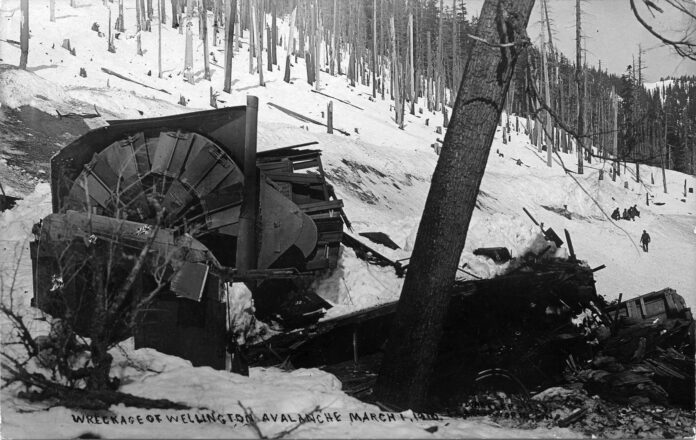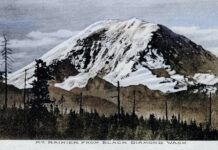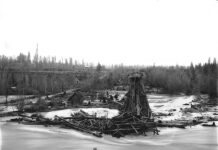Wellington was a small railroad town situated near the summit of the Cascade Mountain range about four miles west of Stevens Pass. In late February 1910, Wellington and the Great Northern Railroad who owned the town were flummoxed by nine days of snow blizzards which dumped nearly a foot per hour. Two trains dispatched from Spokane with a full crew and passengers were stranded on Feb. 23 and unable to continue west to Seattle. A story in that day’s Everett Daily Herald warned, “Not for years has a storm so fierce raged in the Cascade Mountains.”
In the first decades of the 1900s, trains were big business with railroads dominating freight traffic, passenger travel, and mail delivery. Cars and trucks were capable of little more than local delivery, while airplanes were dangerous and carried tiny loads. Each year, Great Northern typically operated 1,400 trains during snowstorms that regularly struck Cascade passes. And, compared to conditions 50 years prior, when a covered wagon journey on the Oregon Trail took five months, by 1910, a scenic train ride from Chicago to Seattle cost $38 and took three days.
The travelers stranded in Wellington accepted their situation during the very first days. The railroad served hot meals and coal-fired stoves kept the passenger cars and sleeping births warm. Some walked through the snow to a Wellington eatery and boarding house run by W.R. Bailet and his wife, Susan. Others played cards and exchanged stories, while the women found ways to entertain the children on board. Still, conditions grew more critical every day. On Feb, 24th, the Seattle Times reported that a solid snow accumulation extended 10 miles in length from Wellington to Alvin putting the Great Northern Railroad in its worst predicament in years. Two days later, snow drifts were 40 to 50 feet in depth.
On Sunday, Feb. 27, the Reverend James Thompson, a stranded traveler and Presbyterian minister from Bellingham comforted a congregation of crew and passengers in a makeshift church service by reading passages from the Bible, the 17th and 27th Psalms. On Monday, the beleaguered and anxious passengers begged railroad officials to park the rail cars inside the 2.5-mile-long Cascade Tunnel as rumors of avalanches frightened both crew and passengers. With more than 400 railroad workers assigned to clear the tracks, it was obvious to most that conditions were dire. Plus, everyone had grown tired from a constant diet consisting of beefsteak and roast beef.
In the wee hours on Tuesday morning, the first day of March came in like a lion when an electric storm raged and strong winds battered Wellington. At 1:15 am, a huge bolt of lightning struck the side of the mountain sending a mile-long sheet of snow cascading down a 2,000-foot slope. The avalanche slammed into the locomotives and train cars and utterly destroyed Wellington. One survivor said it sounded like a thousand cement mixers. The death toll was staggering – 96 people perished including 35 passengers and 61 railway workers and crew.
Next week, more about the Great Wellington Train disaster, rescue attempts, and its aftermath. This photo number 2017.1.90 comes courtesy of the Washington State Historical Society at 315 North Stadium Way in Tacoma. The inspiration for telling this came from Tom Cerne, a Federal Way School District librarian, and the son of a railroading father. Facts about the tragedy were gleaned from Don Moody’s 1998 book, “America’s Worst Train Disaster.”







